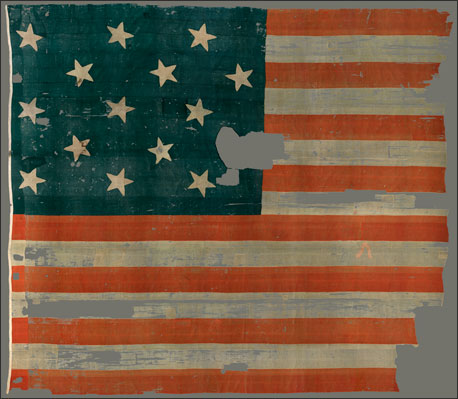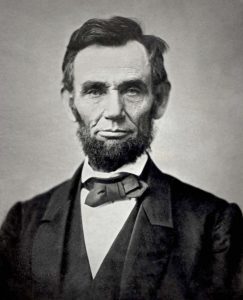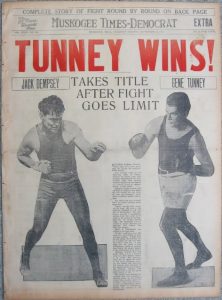Francis Scott Key was born on August 1, 1779 in Terra Rubra, Maryland. After graduating college, Key began to study law in hopes of becoming an attorney.1 Soon after, Keys got married and had eleven children and moved to Georgetown where he started his own practice.2 Key became very successful in his work as a lawyer, and for hobbies he sang for the church and wrote poems, a lot of which are still appreciated today. When the War of 1812 broke out, Key enlisted in the US army.3

Francis Scott Key was sent to a British ship to negotiate the release of certain prisoners. Upon Key’s arrival to the ship, he showed the Commodore of the ship letters from British troops that had been captured by American forces.4 The letters explained how well they were being treated and that they were not harmed in any way. After seeing this, the Commodore let their prisoner William Beanes free, but before the three American men could leave, the British troops were preparing to attack Fort McHenry, and therefore needed to keep them on the ship so that they would not be able to return back to warn the American troops.5
For over twenty-four hours the two sides, American and British, exchanged fire. The British recorded that “over eight hundred shells” were shot at the fort.6 After twenty-four hours of fighting both on land and sea, Francis Scott Key waited for the smoke to clear and saw that the American flag at Fort McHenry was still waving high. Key immediately began to write a poem on what he had witnessed that day. The poem quickly rose to fame and gained the attention of almost every single American.7
Very few people know that the poem went through different phases before becoming the American National Anthem. The original title of the poem was “The Defense of Fort McHenry.” Key later added the tune from an old drinking song called “To Anacreon in Heaven.”8 Later, Congress met to decide on a song for the nation; all songs were rejected, including “The Defense on Fort McHenry.” People that opposed the song claimed that the lyrics were too difficult to sing, it was not martial enough, and it was only about one event in all of American history.9 People who supported the song loved that the lyrics were difficult; that way only professional musicians and singers could sing it before certain important occasions.10
It was not until 1916 that the United States made the “The Star-Spangled Banner” the unofficial nation anthem. Woodrow Wilson was asked to have a “ceremonial song” for the United States, so he picked the most loved song by the people of the United States.11 But it was not until 1931 that Congress adopted the “The Star-Spangled Banner” as the official nation anthem of America. The poem was seen and adored by Americans for the patriotism it stood for and as a reminder of its past victories. This song is now sung before almost every major event in the United States to serve as a reminder of America’s victory against all odds.12
While the first stanza of the poem is widely known and sung today, few have been able to appreciate it in its entirety. Here, then, is the original poem:
O say can you see, by the dawn’s early light,
What so proudly we hail’d at the twilight’s last gleaming,
Whose broad stripes and bright stars through the perilous fight
O’er the ramparts we watch’d were so gallantly streaming?
And the rocket’s red glare, the bomb bursting in air,
Gave proof through the night that our flag was still there,
O say does that star-spangled banner yet wave
O’er the land of the free and the home of the brave?
On the shore dimly seen through the mists of the deep
Where the foe’s haughty host in dread silence reposes,
What is that which the breeze, o’er the towering steep,
As it fitfully blows, half conceals, half discloses?
Now it catches the gleam of the morning’s first beam,
In full glory reflected now shines in the stream,
‘Tis the star-spangled banner – O long may it wave
O’er the land of the free and the home of the brave!
And where is that band who so vauntingly swore,
That the havoc of war and the battle’s confusion
A home and a Country should leave us no more?
Their blood has wash’d out their foul footstep’s pollution.
No refuge could save the hireling and slave
From the terror of flight or the gloom of the grave,
And the star-spangled banner in triumph doth wave
O’er the land of the free and the home of the brave.
O thus be it ever when freemen shall stand
Between their lov’d home and the war’s desolation!
Blest with vict’ry and peace may the heav’n rescued land
Praise the power that hath made and preserv’d us a nation!
Then conquer we must, when our cause it is just,
And this be our motto – “In God is our trust,”
And the star-spangled banner in triumph shall wave
O’er the land of the free and the home of the brave.13
- War of 1812, 2002, s.v. “Key, Francis Scott.” ↵
- War of 1812, 2002, s.v. “Key, Francis Scott.” ↵
- War of 1812, 2002, s.v. “Key, Francis Scott.” ↵
- War of 1812, 2002, s.v. “Key, Francis Scott.” ↵
- UXL Encyclopedia of U.S. History, 2009, s.v. “The Star-Spangled Banner,” by Sonia Benson, Daniel E. Brannen, Jr., and Rebecca Valentine. ↵
- UXL Encyclopedia of U.S. History, 2009, s.v. “The Star-Spangled Banner,” by Sonia Benson, Daniel E. Brannen, Jr., and Rebecca Valentine. ↵
- UXL Encyclopedia of U.S. History, 2009, s.v. “The Star-Spangled Banner,” by Sonia Benson, Daniel E. Brannen, Jr., and Rebecca Valentine. ↵
- “Key, Francis Scott,” in Shaping of America, 1783-1815 Reference Library, edited by Lawrence W. Baker, Richard C. Hanes, Sharon M. Hanes, and Kelly Rudd, Vol. 2, Biographies Volume 1, 257. ↵
- “Key, Francis Scott,” in Shaping of America, 1783-1815 Reference Library, edited by Lawrence W. Baker, Richard C. Hanes, Sharon M. Hanes, and Kelly Rudd, Vol. 2, Biographies Volume 1, 258. ↵
- “Key, Francis Scott.” In Shaping of America, 1783-1815 Reference Library, edited by Lawrence W. Baker, Richard C. Hanes, Sharon M. Hanes, and Kelly Rudd, . Vol. 2, Biographies Volume 1,258. ↵
- “Key, Francis Scott.” In Shaping of America, 1783-1815 Reference Library, edited by Lawrence W. Baker, Richard C. Hanes, Sharon M. Hanes, and Kelly Rudd, Vol. 2, Biographies Volume 1,258. ↵
- UXL Encyclopedia of U.S. History, 2009 s.v. “The Star-Spangled Banner,” by Benson, Sonia, Daniel E. Brannen, Jr., and Rebecca Valentine. ↵
- Francis Scott Key, “The Star-Spangled Banner” (wording of the original handwritten manuscript, in the Museum Department of the Maryland Historical Society). ↵



101 comments
Daniela Cardona
I remember being much younger sitting in music class every year and learning of the history of the National Anthem at least once a year. I have always thought the way Francis Scott Key wrote it was very cool. Seeing that he saw actual bombs blasting as he wrote it makes it seem more real to me. I like how the author wrote this article, even though I knew much of the information, it still kept me very interested.
Sofia Andrade
In elementary I had briefly learned about the history behind our national anthem. Over the years I forgot the history so it was interesting refreshing on how our national anthem came to be. It is interesting to know of the process that our now national anthem underwent. I did not know that it was disapproved many times and the initial title was changed to the title we know it as today.
Belene Cuellar
In my opinion I do agree that the national anthem does only focus on one moment in American history. But, it does bring the moral and patriotism of the people up. All things considered this song is held up with high regards regardless of what anyone says. The national anthem stands as our pride and glory as a nation no matter what anyone says.
Greyson Addicott
Personally, I like our old national anthem much better than the one Key’s spent a few days creating. Indeed, we have replaced the idea of manifest destiny and God by centering upon a single battle in the history of our nation. The idea of Union is wholly absent throughout the poem, and it focuses upon the military of America rather than its unique form of government and varied interests. Other nations have a particular way of expressing their national pride, but we chose, again, to focus upon a single battle.
Brianna Ford
I never really knew much of the history behind the song Star Spangled Banner and who created the piece, which what drove me to read this article. This was a good informative article on the writer and the history of the song. What caught me by surprised is that Francis Scott Key was there during the battle and wrote it as a poem while the action was happening. Shows what great talent he had to create such a historical piece that is forever used to honor our nation. The original poem is very well written, this was an enjoyable article.
Harashang Gajjar
Francis Scott Key was a gifted amateur poet. Inspired by the sight of the American flag flying over Fort McHenry the morning after the bombardment, he scribbled the initial verse of his song on the back of a letter. Back in Baltimore, he completed the four verses and copied them onto a sheet of paper, probably making more than one copy. A local printer issued the new song as a broadside. Shortly afterward, two Baltimore newspapers published it, and by mid-October it had appeared in at least seventeen other papers in cities up and down the East Coast.
Jose Fernandez
Even though I am not from the United States, I have always liked their national anthem. I think it is inspirational and it gives me chills every time I hear it before a basketball game. I knew nothing about its origin and this article really informed me. I can tell it is very well researched and It is very organized. I find interesting that everything started with a poem.
Luke Lopez
It is great to learn the history behind the national anthem, and what the words actually mean when we are singing it. I did not know that the Star Spangled Banner was originally titled “The Defense of Fort McHenry”. It is incredible how a poem by Francis Scott Key was popularized to the extent that everyone in America and around the world recognizes the United States national anthem.
Richard Morales
I never knew the story behind our national anthem. I feel enriched to have read this article. It is interesting to hear the story behind the battle song. I now can fully appreciate the lyric, “and the flag was still there” since I found out the inspiration. It’s ironic that the original tune was that of a drinking song, although its quite fitting that the poem was written by an American veteran.
Valeria Perez
I learned about the general idea of this event in elementary, but I did not know that titled “The Defense of Fort McHenry” our anthem had been dismissed. I also didn’t know that it took us so long to officially adopt an anthem!
Nowadays we can’t imagine any other song representing our country.
I appreciate that the author gave us a background of Francis Scott Key.